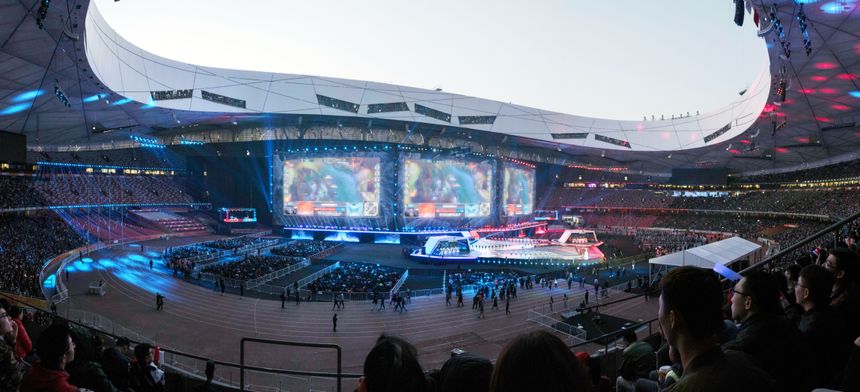In recent years, esports has grown from a niche hobby into a global phenomenon, transforming the landscape of entertainment and sports. Once confined to basements and small gatherings, esports now fills stadiums, attracts millions of online viewers, and generates billions of dollars in revenue. This article explores the fascinating journey of esports, its evolution, its cultural impact, and what the future holds for this rapidly growing industry.
Early Beginnings: The Birth of Competitive Gaming
The Dawn of Competitive Gaming (1970s-1980s)
The roots of esports can be traced back to the 1970s and 1980s when early video game competitions began to take shape. One of the earliest recorded competitive gaming events was the 1972 Intergalactic Spacewar Olympics held at Stanford University. Students competed in “Spacewar!”, a classic computer game, for a year-long subscription to “Rolling Stone” magazine. This event is often considered the first official video game tournament, marking the dawn of competitive gaming.
As arcade games like “Pong” and “Pac-Man” gained popularity, local competitions and high-score challenges became common. These early contests laid the groundwork for organized competitive gaming, fostering a sense of community among players who shared a passion for video games.
Key Early Competitions:
-
- 1972 Intergalactic Spacewar Olympics: Considered the first video game tournament, featuring the game “Spacewar!” at Stanford University.
- 1980 Atari National Space Invaders Championship: One of the first large-scale competitions, attracting over 10,000 participants across the United States.
The Rise of Arcade Competitions (1980s)
The 1980s saw a boom in arcade culture, leading to the rise of arcade competitions. Games like “Space Invaders,” “Pac-Man,” and “Donkey Kong” became the focal points of high-score competitions, with players striving to achieve the highest scores and gain recognition in their local communities. In 1980, the Atari National Space Invaders Championship became one of the first large-scale video game tournaments, attracting over 10,000 participants across the United States.
Arcades served as social hubs where gamers could compete against each other and share strategies. This era marked the beginning of competitive gaming as a social activity, laying the foundation for the future of esports.
The Introduction of Home Consoles and Online Multiplayer (1990s)
The 1990s brought significant advancements in gaming technology, with the introduction of home consoles like the Nintendo Entertainment System (NES) and the Sega Genesis. These consoles allowed players to compete from the comfort of their homes, further fueling the growth of competitive gaming. Titles like “Street Fighter II” and “Mortal Kombat” became staples in competitive gaming circles, leading to the emergence of organized tournaments.
The rise of the internet and online multiplayer gaming in the late 1990s revolutionized competitive gaming. Games like “Quake” and “StarCraft” introduced players to online battles, connecting gamers worldwide. This shift marked the beginning of esports as we know it today, with players forming teams and competing in online tournaments.
Key Developments:
-
- Home Consoles: The introduction of consoles like the NES and Sega Genesis brought competitive gaming into homes.
-
- Online Multiplayer: Games like “Quake” and “StarCraft” revolutionized competitive gaming with online battles and tournaments.
The Rise of Esports: The 2000s and Beyond
The Emergence of Professional Esports Leagues
The early 2000s marked a significant turning point in the evolution of esports, as professional leagues and tournaments began to take shape. One of the most influential organizations during this period was the Cyberathlete Professional League (CPL), founded in 1997. The CPL hosted several major tournaments, including the CPL World Championship, which featured games like “Counter-Strike” and “Unreal Tournament.”
In South Korea, esports gained massive popularity with the rise of “StarCraft.” The Korean eSports Association (KeSPA) was established in 2000, and esports events began to draw large audiences, both in-person and on television. South Korea quickly became a global hub for esports, with professional players achieving celebrity status and enjoying lucrative careers.
Key Organizations and Leagues:
-
- Cyberathlete Professional League (CPL): Founded in 1997, the CPL was one of the first organizations to host professional esports tournaments.
-
- Korean eSports Association (KeSPA): Established in 2000, KeSPA played a crucial role in promoting esports in South Korea, particularly with “StarCraft.”
- Major League Gaming (MLG): Founded in 2002, MLG became a prominent North American esports organization, hosting tournaments for games like “Halo” and “Call of Duty.”
The Growth of Streaming Platforms and Online Viewership
The mid-2000s saw the rise of streaming platforms like Twitch, which revolutionized how esports content was consumed. Launched in 2011, Twitch allowed players to broadcast their gameplay live to millions of viewers worldwide, creating a new form of entertainment and community interaction. This accessibility contributed to the exponential growth of esports viewership, with millions tuning in to watch their favorite players and teams compete.
Streaming platforms also provided aspiring players with a platform to showcase their skills and build their brands. Professional gamers like Ninja (Tyler Blevins) and PewDiePie (Felix Kjellberg) gained massive followings, turning their passion for gaming into lucrative careers.
Impact of Streaming Platforms:
-
- Increased Accessibility: Streaming platforms like Twitch made esports content accessible to a global audience, driving viewership and engagement.
-
- Player Exposure: Aspiring players could showcase their skills and build their brands, leading to new career opportunities.
-
- Community Building: Streaming platforms fostered vibrant gaming communities, connecting fans and players worldwide.
The Emergence of Major Esports Titles
The 2010s witnessed the emergence of major esports titles that continue to dominate the competitive gaming scene. Games like “League of Legends,” “Dota 2,” “Counter-Strike: Global Offensive,” and “Overwatch” became household names, drawing massive player bases and hosting tournaments with multi-million dollar prize pools.
“League of Legends,” developed by Riot Games, became one of the most popular esports titles globally. Its annual League of Legends World Championship attracts millions of viewers, with the 2020 finals drawing over 45 million unique viewers. The game’s strategic depth, constant updates, and passionate community have contributed to its enduring success.
“Dota 2,” developed by Valve Corporation, is known for its prestigious tournament, The International. The tournament’s prize pool is crowdfunded by the community, often exceeding $30 million, making it one of the most lucrative esports events in history.
Key Esports Titles:
-
- “League of Legends”: A strategic MOBA game that hosts the annual League of Legends World Championship, attracting millions of viewers.
-
- “Dota 2”: Known for its prestigious tournament, The International, with prize pools often exceeding $30 million.
-
- “Counter-Strike: Global Offensive”: A tactical first-person shooter with a dedicated competitive scene and major tournaments like the ESL Pro League.
-
- “Overwatch”: A team-based shooter with a vibrant esports ecosystem and leagues like the Overwatch League.
The Globalization of Esports
Esports has become a truly global phenomenon, transcending geographical boundaries and cultural differences. Major tournaments are held worldwide, from North America to Europe, Asia, and beyond. Cities like Los Angeles, Seoul, and Shanghai have become esports hubs, hosting prestigious events that draw fans from all corners of the globe.
The international appeal of esports is further amplified by the diversity of games that cater to different audiences. Whether it’s the strategic gameplay of “League of Legends,” the fast-paced action of “Fortnite,” or the tactical precision of “Counter-Strike,” there’s an esport for every type of gamer.
Global Reach:
-
- International Tournaments: Major esports events are held worldwide, attracting fans and players from diverse backgrounds.
-
- Diverse Game Selection: A wide range of esports titles caters to different audiences, ensuring global appeal.
-
- Cultural Exchange: Esports fosters cultural exchange and understanding, bringing together fans from different regions.
The Cultural Impact of Esports
Redefining Sports and Entertainment
Esports has redefined the traditional notions of sports and entertainment, blurring the lines between virtual and physical competition. While traditional sports require physical prowess, esports demands mental agility, strategic thinking, and teamwork. The rise of esports has sparked debates about whether it should be considered a legitimate sport, with organizations like the International Olympic Committee (IOC) exploring its potential inclusion in future Olympic Games.
The entertainment industry has also taken notice of esports’ growing influence. Celebrities, athletes, and major brands have invested in esports teams and events, further legitimizing its status as a mainstream form of entertainment. Partnerships between esports organizations and entertainment giants have resulted in collaborations that bridge the gap between gaming and popular culture.
Key Cultural Impacts:
-
- Redefining Sports: Esports challenges traditional notions of sports, emphasizing mental agility and teamwork over physical prowess.




